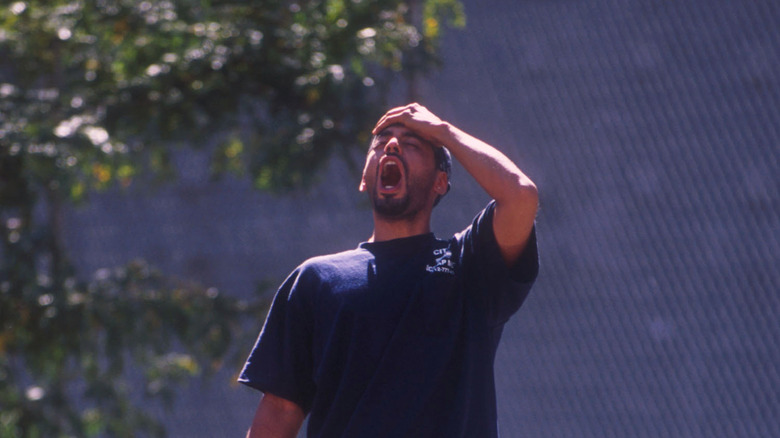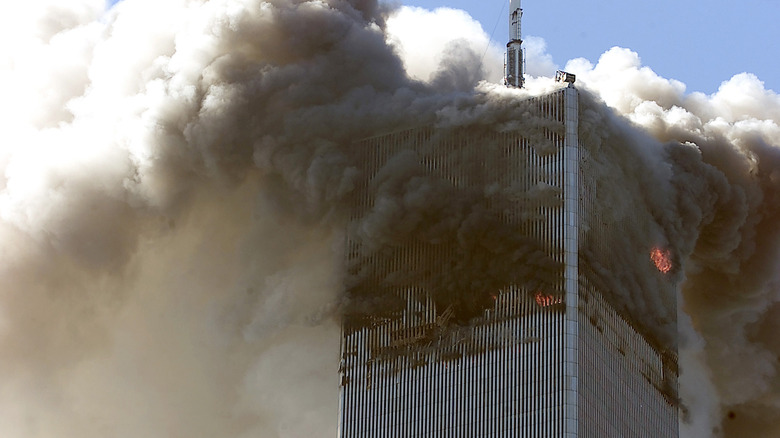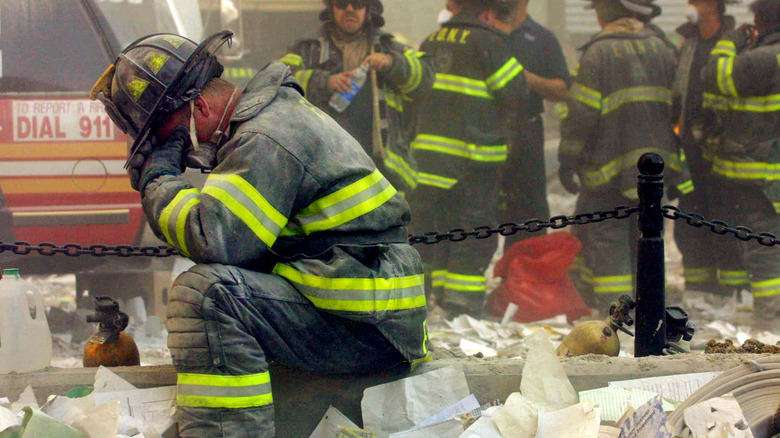Tragic Reasons Why People Fell From The World Trade Center On 9/11
At a moment in history replete with heartbreaking images, it was the one that, for many, was too much. Richard Drew's photograph of a man falling from the World Trade Center on September 11, 2001, was condemned for being ghoulish, exploitative, and unfeeling. There were newspaper editors who refused to run it. "Americans don't want to look at pictures of death and dying over their morning cornflakes," one told Drew (per the Associated Press). Papers that did run the photo felt the need to explain themselves, and Drew's office received upset calls and emails.
That photograph, since dubbed "The Falling Man," remains one of the starkest images of the 9/11 terrorist attack, and its reputation has been rehabilitated with time. But the thought of anyone falling from that fiery wreckage to their deaths from a hundred stories up is no less unsettling. Estimates of how many people jumped or fell from the towers have struggled with a number; per The New York Times, it could have been less than 100, or north of 200. Most of them came from the north tower, the first hit and the one with more people in a more confined space.
Why did they jump? Drew, who never knew the identity of the man he'd photographed, speculated in The Digital Journalist that, faced with certain death, it was a choice between falling or fire.
High-rise fires forced many out the windows
Per USA Today, the first people who leapt from the Twin Towers on 9/11 were initially mistaken as debris by onlookers. Jumping was observed continuously from the time the towers were struck to the time they collapsed. The majority of people who jumped came from the 100th, 105th, 106th, and 107th floors of the north tower. The lower of those levels housed offices for the bond firm Cantor Fitzgerald, and the upper stories housed the Windows on the World restaurant. Those who fell did so at around 150 miles per hour, a sure death sentence upon impact.
Having been struck at a higher level than the south tower, the smoke and heat of the north tower were more intensely concentrated on a smaller number of floors for a longer duration, 102 minutes. The smoke and heat would have circulated through stairwells and elevator shafts, at such intensity that some of the people who fell may have been blown out, or forced by the pressure of huddling against windows. Many more were trying to escape the heat, which reached over 1,000 degrees in some places. The New York Times reported on phone conversations that placed numerous people in walled-off rooms, comparatively safe from the heat, before the north tower collapsed. But for those who couldn't reach shelter or make for an exit (impossible from the 92nd floor up), jumping may have been a less agonizing death than burning in such intense heat.
No one who fell from the towers has never been identified
Before the north tower collapsed, fire battalion chief Joseph Pfeifer tried to encourage those on the upper floors to hang on, that help was on the way. But the public address system of the tower was destroyed (per The New York Times), and observers on the ground and in helicopters saw people jump, some alone and some holding hands. Per Esquire, some tried to use makeshift parachutes, and one person fell into a fireman below, killing them both.
It was impossible to determine if any remains collected after the attack were those of people who had jumped; per USA Today, injuries on the bodies were so similar that any precise cause of death couldn't be determined. All were ruled as homicides, and officials pointedly did not describe the people who chose to jump as "jumpers," a term used for people who choose to jump with the intent to commit suicide. "This should not be really thought of as a choice," fire marshal Louis Garcia told the Times.
More than 20 years after the attack, 9/11 victims are still being identified. But putting faces to those who fell remains nearly impossible even by photograph, given the great distance at which all such photos were taken. Richard Drew's infamous "Falling Man" was at one point identified as Norberto Hernandez by the Globe and Mail (via Esquire), but his family rejected the claim, and whether further investigation would bring pain or closure is an open question.


